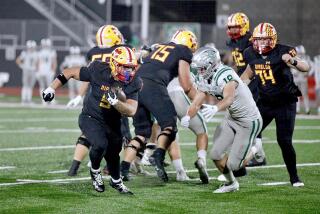There’s Not Enough Payoff for a Playoff
- Share via
Thirty-eight teams divided and shared $64 million.
Nineteen teams ended their seasons happy.
Two teams could lay claim to a national championship.
And so goes the preamble of the constitution for the NCAA’s collegiate bowl preservation society. In Blockbuster Video and USF&G; We Trust. No crowd-pleasing, sense-making, controversy-quelling national championship playoff needed here. Give us our syndicated TV packages, our corporate sponsorships, our schools that travel well. We’ll give you Liberty and Freedom and Independence--when we aren’t stuffing you with Raisins and Peaches or plying you with Copper.
There is no chance for a national football playoff before the turn of the century, says Don Andersen, executive director of the Freedom Bowl, because no one who really matters really wants one.
“The college presidents are not for it,” Andersen said. “The coaches are not for it. The NCAA is not for it. Obviously, the media would like it because it would be something interesting for them to cover.”
We repeat: No one who really matters really wants one.
Still, the protectors of the bowls are not above tinkering with them. They say they have arrived at the perfect union--but that’s not to say a more perfect union isn’t out there somewhere.
New proposals flowed like Scotch and water at the recent bowl directors’ meetings in Orlando, Fla. One suggested a merger of college football’s two most high-profile traditions--the bowls and the draft--and allowing the best teams in the country to “draft” which bowl they wanted as their postseason reward. With the Hall of Fame Bowl expired, these teams would have 18 bowls from which to choose.
Andersen explained the idea this way:
“After the first Saturday in December, the top 36 teams in the country would receive their choice of bowls in a reverse-order draft. ‘OK, Notre Dame, you’re No. 1. Where do you want to go? USC, you’re No. 2, you’re already bound to the Rose Bowl. Pitt, you’re No. 3. Where do you want to go?”
Andersen is pleased to report that the proposal “didn’t get out of committee. We hated it. “What if we ended up in the middle of the pack and let’s say we’re down to North Carolina State and Duke, both with 7-4 records, and they say, ‘OK, we’d like to go to the Freedom Bowl?’ They’re not going to bring anybody, there’s no national interest in the game, there’d be no local interest, there’d be no TV interest.
“Two teams would have a nice 10 days out here on us and they’d go home with $650,000 apiece.
“It was a terrible idea. Thankfully, the NCAA left it on the table.”
Another brainstorm targeted the Freedom Bowl directly, and had it happened five years earlier, the Freedom Bowl probably would have jumped at it.
The Pacific 10 offered a contractual tie-in that would have guaranteed the Freedom Bowl its third- or fourth-place finisher every year.
“We looked back at the records of the third-place teams in the Pac-10 over the last 10 to 12 years and it would’ve been a very good thing for our game,” Andersen said. “We would’ve had USC three times, Washington four times, UCLA twice, Arizona State twice.
“But we didn’t want the image of a third-place or fourth-place bowl, especially now, the way we’re going. We can get those caliber teams, or better, without a pact.”
As it stands after seven installments, a Pac-10 pactless Freedom Bowl has featured Washington twice, UCLA once, Arizona State once and, last December, Oregon.
The NCAA eventually vetoed the idea and limited bowl-conference agreements to conference champions, which nixed another proposal by the wheeling, dealing Pac-10--our second-place team into your Fiesta Bowl.
UCLA probably would’ve tired of watching the Rose Bowl on Tempe TV, anyway.
Andersen said the Freedom Bowl will continue to pursue Pac-10 contestants, but at its own speed. Rev up and sign a major corporate underwriter, offer guarantees of $1.5 million, and USC and UCLA will be in the crosshairs. Continue idling at the present pace, with per-team payouts of $650,000, and any 8-3 or 7-4 Pac-10 team will remain Objective No. 1.
“If we can’t get SC or UCLA in this game, the next best thing is a California Pac-10 school,” Andersen said. Last December, Freedom VII gambled on a non-California Pac-10 school, Oregon, and won going away on the scoreboard (Colorado State, 32-31) and in the stands (41,000-plus).
Already, Andersen has his sights set on either Stanford or Cal for one spot in the 1991 game.
“Stanford has 18 starters back, but a very, very difficult schedule,” Andersen noted, making Stanford a very, very Freedom-friendly team. “They play Washington, Arizona, Colorado and Notre Dame all in their first four games.
“So you don’t expect Stanford to go 10-1, but they might be 7-4 or 8-3--and they would be the type of team that would look at our game as a step up.
“Cal has seven starters back on offense, including Russell White and a local kid at quarterback, (Troy High’s Mike) Pawlawski. They also have UOP, Purdue and San Jose State on their schedule, so, conceivably, they could win seven or eight games, too.”
And how does Andersen stand on the issue of a national playoff?
Did we need to ask?
“We’re against it right now,” he said. “We feel we can become a major player in the bowl picture, get into the top 10 bowls. We feel that’s a realistic goal for us now.”
But just in case the tide of popular sentiment ever turns. . . .
“If there ever is a national championship,” Andersen said, armed today for the pitch of tomorrow, “I think we’d be in an ideal situation to host one here.”
More to Read
Go beyond the scoreboard
Get the latest on L.A.'s teams in the daily Sports Report newsletter.
You may occasionally receive promotional content from the Los Angeles Times.










